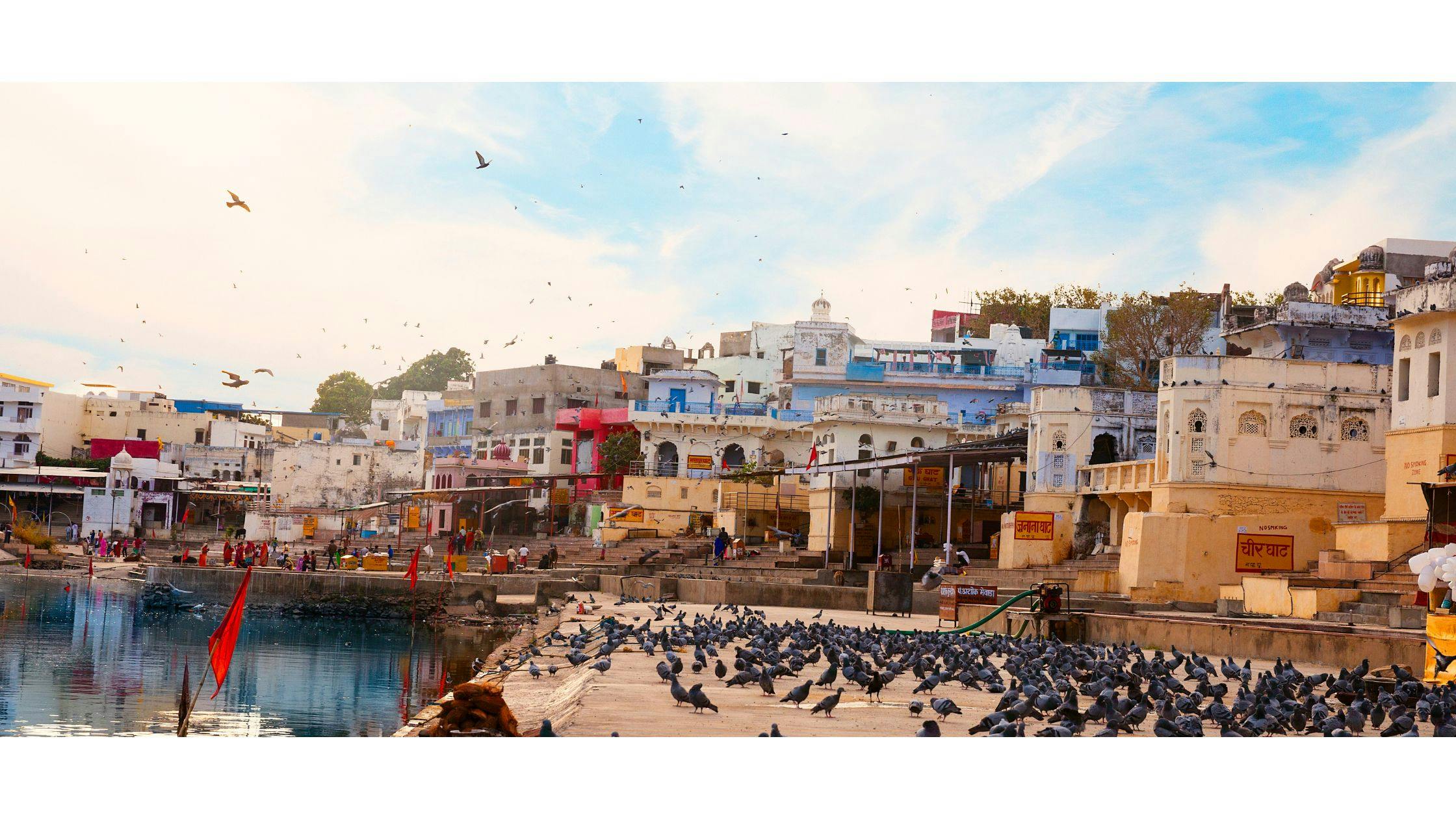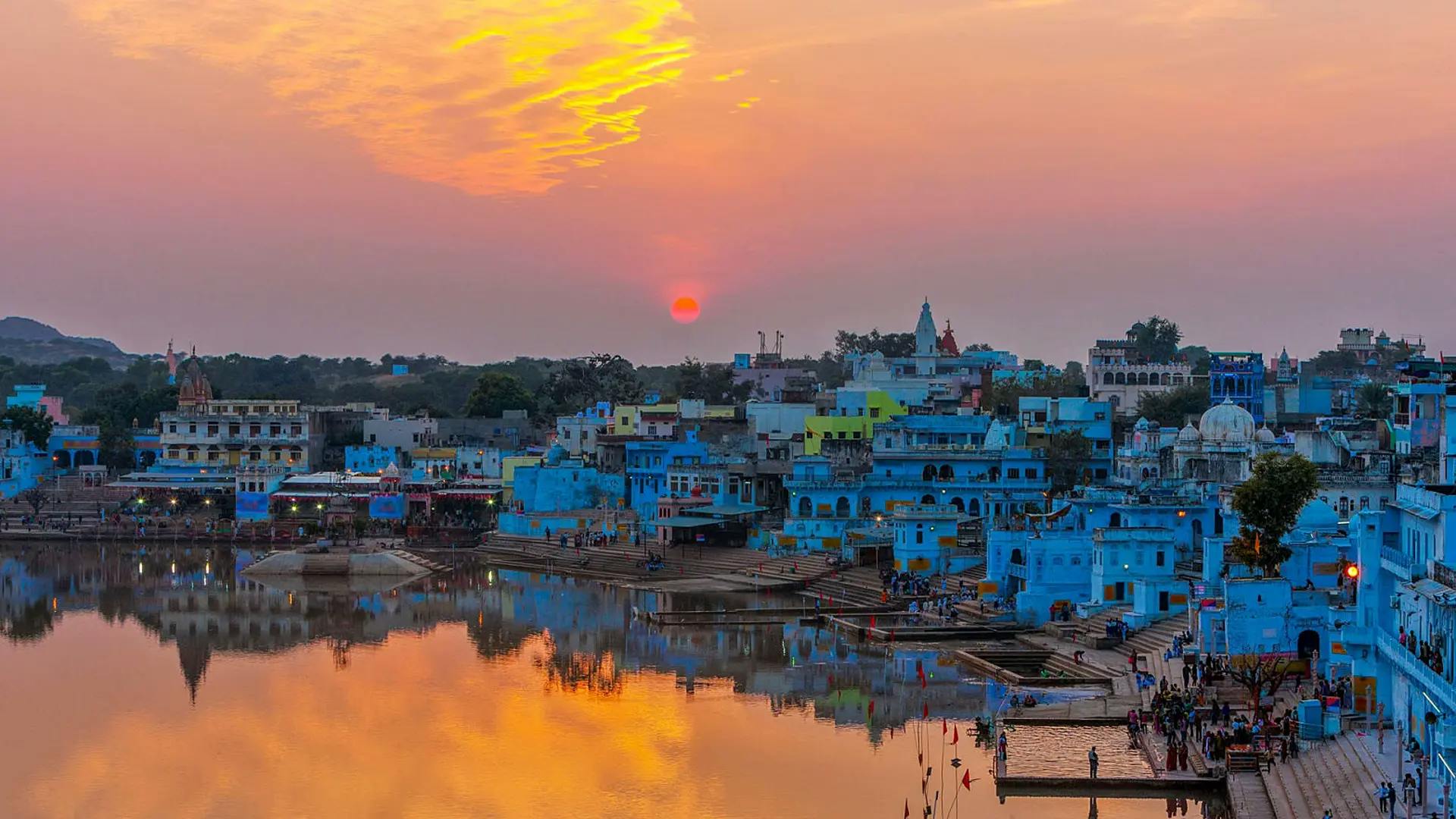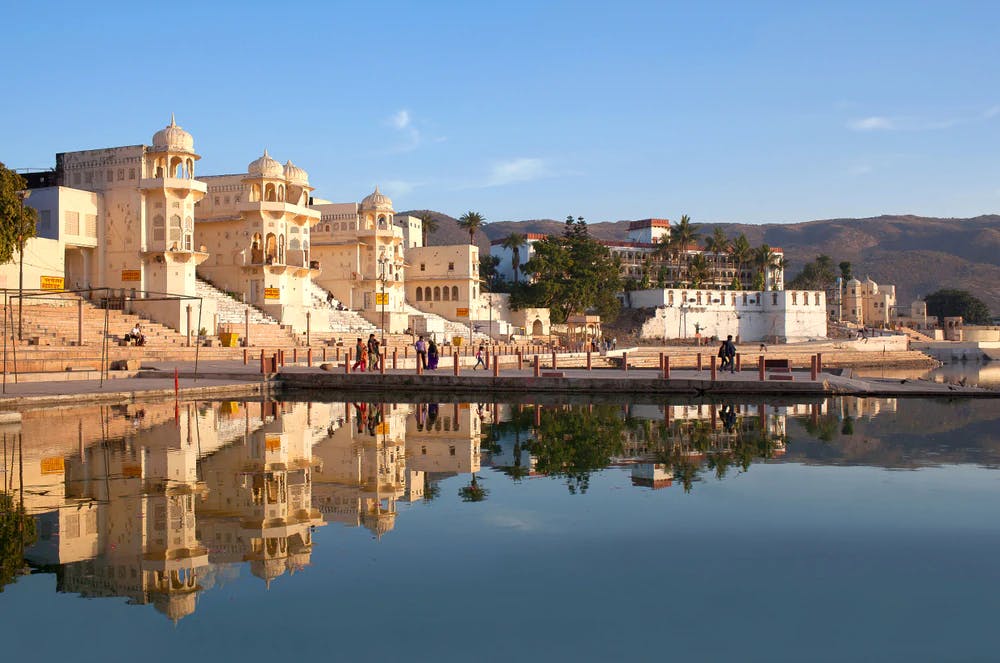Best Time to Visit Pushkar

Known for its spiritual energy and vibrant atmosphere, Pushkar is a captivating town nestled in the heart of Rajasthan. Famed for the sacred Pushkar Lake, ancient temples, and the legendary Pushkar Camel Fair, this town invites travelers from across the globe. Unlike the bustling cities of Rajasthan, Pushkar offers a serene yet colorful blend of spirituality and culture, wrapped in the golden sands of the desert.
From sunrise prayers at the ghats to late-evening shopping in vibrant bazaars, Pushkar promises a soul-stirring experience. Whether you're a spiritual seeker, a curious traveler, or a cultural enthusiast, understanding the best time to visit Pushkar is crucial to making the most of your journey.
Explore the best places in Pushkar, from sacred sites and stunning temples to peaceful lakes, and discover what makes this vibrant town truly unforgettable.
Overview of Pushkar Climate and Travel Seasons
Pushkar experiences three main seasons: summer, monsoon, and winter, each offering a unique charm to travelers. The best time to go to Pushkar is during the cooler months when the weather is pleasant and perfect for sightseeing. Summers can be extremely hot, while monsoons bring brief relief and lush surroundings. For a comfortable and culturally rich trip, the best time to visit Pushkar is typically from October to March.
Climate and Travel Seasons of Pushkar, Rajasthan
Best Months to Visit Pushkar: Month-by-Month Guide
October: The Onset of Pleasant Weather
Temperature: 18°C to 34°C
Season: Post-monsoon transition
October marks the beginning of the favorable season in Pushkar. The weather becomes more comfortable, making it suitable for exploring the town's spiritual sites and vibrant markets. This period is often considered the best time to go to Pushkar for those seeking a balance between pleasant weather and fewer crowds.
Travel Highlights:
- Visit the Brahma Temple and Pushkar Lake
- Explore local bazaars for handicrafts
- Enjoy the serene ambiance before the festival season
Pro Tip: Book accommodations early to secure the best options as the tourist season begins.
November: Cultural Festivities and the Camel Fair
Temperature: 15°C to 28°C
Season: Peak tourist season
November is renowned for the Pushkar Camel Fair, a vibrant event attracting visitors worldwide. The town buzzes with cultural activities, making it the best time to visit Pushkar for those interested in local traditions and festivities.
Travel Highlights:
- Experience the Pushkar Camel Fair with its array of events
- Participate in cultural performances and competitions
- Shop for traditional Rajasthani crafts
Pro Tip: Plan your visit around the full moon to witness the fair at its peak.
December: Tranquil Exploration
Temperature: 10°C to 25°C
Season: Cool and dry winter
December offers a peaceful atmosphere, ideal for spiritual seekers and those wanting to explore Pushkar's heritage sites without the festival crowds. The weather remains pleasant, reinforcing this period as the best time to go to Pushkar for a relaxed experience.
Travel Highlights:
- Attend evening aartis at Pushkar Lake
- Explore the town's temples and Ghats
- Enjoy the cool evenings with local cuisine
Pro Tip: Carry warm clothing for the cooler nights.
January: Spiritual Serenity
Temperature: 8°C to 24°C
Season: Mid-winter calm
January continues the serene ambiance, with clear skies and cool temperatures. It's an excellent time for introspection and spiritual activities, aligning with the best time to visit Pushkar for personal retreats.
Travel Highlights:
- Participate in yoga and meditation sessions
- Visit nearby temples and ashrams
- Enjoy the peaceful surroundings
Pro Tip: Engage with local spiritual guides for a deeper experience.
February: Romantic and Cultural Bliss
Temperature: 11°C to 26°C
Season: Late winter warmth
February brings a gentle warmth, making it perfect for couples and cultural enthusiasts. The pleasant climate and fewer tourists enhance the experience, marking it as the best time to go to Pushkar for a romantic getaway.
Travel Highlights:
- Enjoy sunset views over the lake
- Attend local music and dance performances
- Explore the town's art and craft scene
Pro Tip: Plan a camel safari to experience the desert landscape.
Elevate your journey with our specially crafted Pushkar Tour Packages offering the perfect mix of spirituality, charm, and cultural depth.
Off-Season in Pushkar: Should You Visit?
Traveling to Pushkar during the off-season might not appeal to every traveler, but for those seeking quiet charm, spiritual calm, and budget-friendly stays, it’s a hidden gem. Let’s explore why the summer and monsoon seasons can be surprisingly rewarding times to experience this sacred town in Rajasthan.
Pushkar in Summer (March to June)
Temperature Range: 30°C to 45°C
Season Type: Hot, dry, and sun-drenched
Pushkar’s summer is marked by intense heat and minimal rain, making it the official off-season. However, with fewer crowds and deep discounts on accommodations, it's ideal for travelers looking for peace and affordability in this holy town.
Why Visit Pushkar in Summer:
- Budget-friendly accommodations and food
- Uninterrupted time at temples and Ghats
- Perfect for sunrise/sunset photography with golden light and minimal haze
Who Should Visit in Summer:
- Solo travelers or spiritual seekers wanting fewer distractions
- Budget backpackers and digital nomads
- Photographers focusing on architecture, rituals, and early morning scenes
Tips to Beat the Summer Heat:
- Plan outdoor visits before 10 AM or after 6 PM
- Wear breathable cotton clothing, a wide-brimmed hat, and sunscreen
- Stay hydrated with bottled water and fresh lime sodas
- Visit indoor attractions like the Brahma Temple and local art cafés during the afternoon
Pushkar in Monsoon (July to September)
Temperature Range: 25°C to 35°C
Season Type: Rainy, lush, and poetic
The monsoon rains breathe new life into Pushkar’s desert surroundings. The hills turn green, the lake swells, and the town wears a refreshed, romantic vibe. Though the rains can be unpredictable, they bring with them a unique tranquility perfect for soulful escapes.
Why Visit Pushkar in Monsoon:
- The Pushkar Lake fills up, creating scenic reflections
- Great time for discounted travel and boutique hotel stays
- Calm environment ideal for meditation, writing, and art
Who Should Visit in Monsoon:
- Couples looking for a quiet, rainy escape
- Spiritual travelers and yoga retreat participants
- Nature lovers and monsoon chasers
Precautions & Travel Tips:
- Carry rain gear: Umbrella, waterproof shoes, and a light rain jacket
- Monitor local weather before outdoor plans
- Avoid slippery paths around hills and rocky temples
- Enjoy indoor experiences like Ayurvedic spas, cooking classes, and art workshops
Best Time to Visit Pushkar for Different Travelers
Pushkar, the sacred town nestled in Rajasthan’s Aravalli hills, offers distinct experiences throughout the year. Whether you're a spiritual seeker, a budget backpacker, or a honeymooning couple, there's a perfect time to explore Pushkar’s magic. Here’s a seasonal guide to help you plan your trip based on your travel style and interests.
For Couples & Honeymooners
Recommended Months: October to February
Why: The winter months offer pleasant weather, misty mornings, and a romantic backdrop with the serene Pushkar Lake and majestic Ghats, perfect for intimate moments and memorable photo ops.
Highlights:
- Sunset boat rides on Pushkar Lake
- Scenic rooftop dining with panoramic views
- Comfortable weather for temple visits and walks around the Ghats
- Ideal for pre-wedding shoots and romantic getaways
For Budget Travelers
Recommended Months: March to June (Summer) & July to September (Monsoon)
Why: These months are Pushkar's off-season, so accommodation, food, and transport are much more affordable. While the heat can be intense in summer, monsoon brings a touch of greenery and cooler winds.
Perks:
- Deep discounts on heritage hotels and guesthouses
- Fewer tourists mean more peaceful exploration
- Great bargains at the local Pushkar bazaars
For Spiritual Seekers & Pilgrims
Recommended Months: October to March
Why: The climate is ideal for temple hopping, meditation, and spiritual immersion. Visiting during festivals like Kartik Purnima enhances the divine experience.
Must-Do:
- Attend the morning aarti at Brahma Temple
- Participate in sacred bathing rituals at Pushkar Lake
- Visit gurus and ashrams for meditation or yoga retreats
For Photographers & Creatives
Recommended Months: November to February & July to September
Why: Winter offers sharp skies, rich colors, and bustling festivals, while monsoon reveals lush green hills, dramatic skies, and reflections on the lake.
Best Shots:
- Golden hour at the Ghats
- Portraits of pilgrims and sadhus during festivals
- Aerial views of the town ringed by the Aravalli's
- Rain-drenched temples and vibrant monsoon clouds
For Culture Lovers & Festival Goers
Recommended Months: October to November
Why: This is the time of the iconic Pushkar Camel Fair, one of India’s most vibrant cultural festivals. Experience traditional music, camel parades, local crafts, and spiritual rituals all in one place.
Highlights:
- Witness camel races, folk dances, and puppet shows
- Explore the colorful mela grounds with artisans and performers
- Immerse yourself in Rajasthani culture and cuisine
As you explore Pushkar’s rich culture, don't miss out on exciting activities – check out our Things to Do in Pushkar for local experiences and adventures.
Festival Season in Pushkar: When to Visit for Celebrations
Pushkar, a sacred town nestled in Rajasthan, is famous not just for its religious significance but also for its vibrant festival calendar. If you want to witness Rajasthani culture, spiritual rituals, and colorful local traditions, timing your visit around one of Pushkar’s major festivals is a brilliant idea.
Pushkar Camel Fair (October–November)
Also Known As: Pushkar Mela
Duration: 7–10 days around Kartik Purnima (full moon in November)
One of India’s most iconic cultural festivals, the Pushkar Camel Fair draws travelers, photographers, and traders from around the world. It’s a spectacle of livestock trading, spiritual rituals, folk arts, and carnival-like fun.
Festival Highlights:
- Camel races, beauty contests, and traditional competitions
- Sunrise hot air balloon rides and sunset photography
- Folk music, Kalbelia dances, and puppet shows
- Holy dips in Pushkar Lake during Kartik Purnima
Why Visit: To experience Rajasthan’s largest fair, a blend of spirituality and culture like no other.
Diwali in Pushkar (October–November)
Festival of Lights
During Diwali, Pushkar glows with lamps, candles, and fireworks. Temples are adorned with flowers, homes are lit with Diya's, and the markets are buzzing with festive shopping.
Festive Vibes:
- Illuminated temples and Ghats around Pushkar Lake
- Bustling bazaars selling sweets, Diya's, and ethnic wear
- Firework displays and night-time festivities
Why Visit: A spiritually enriching and romantically magical time to explore the holy city.
Holi Festival in Pushkar (March)
Festival of Colors
Holi in Pushkar is energetic, joyful, and safe for international travelers. The town turns into a giant dance floor, with colors in the air and music on the streets.
What to Expect:
- Street DJs and dance parties
- Organic colors and vibrant crowd
- Community celebrations at temples and lakeside
Why Visit: Holi in Pushkar is globally famous for being fun, friendly, and photogenic.
Pushkar Dance & Music Festival (Various Dates)
Though smaller in scale, this cultural event showcases Rajasthani folk music, dance, and classical performances in intimate settings around Pushkar.
Cultural Experience:
- Live music under starlit skies
- Instrumental and devotional performances
- Great for cultural travelers and art lovers
Why Visit: A lesser-known gem for authentic music and heritage performances.
Plan Your Visit Around Pushkar’s Festivals
Whether you seek spiritual fulfillment, cultural exploration, or festival photography, Pushkar offers memorable experiences during every celebration.
Pro Tip: Book your stay early during the Pushkar Fair or Diwali, as accommodations fill up quickly.
Looking to plan your budget? Check out our Pushkar trip cost for everything from hotel prices to local food and shopping tips.
Final Thoughts
Pushkar is more than just a holy town, it's a living celebration of culture, faith, and tradition. Whether you're drawn by the world-famous Pushkar Camel Fair, the sacred Diwali rituals, or the vibrant Holi celebrations, visiting Pushkar during festival season offers authentic experiences and unforgettable moments. It’s the perfect destination for photographers, spiritual seekers, and cultural travelers alike.



